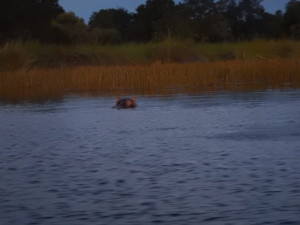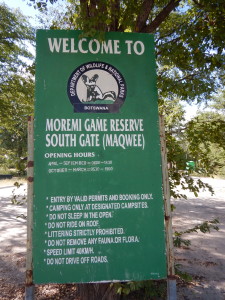April 5, 2016
After dinner, we naturally made our way to the ablution block, a.k.a. camp bathrooms. It was dark so we decided to drive the 200 meters or so. Not far, but as someone in our group pointed out, “it’s not safe to walk”.
We are after all, in the middle of Botswana’s Moremi Game Reserve in an unfenced camp site at Xakanaxa. To pronounce this wonderful name correctly, you need to add a click right before each “x”. Moremi is wild Africa at her best.
Stepping out of the vehicle at the bathroom building, we looked around for the entrance. The light from our headlamps fell upon trees and an array of columns in front of the bathroom doors.
It turned out those were not columns. They were the legs of an elephant eating leaves from a tree next to the rest rooms. Oh…. Well….. We did what all tourists do. We took photos of the elephant, ourselves with the elephant. (sadly those photos are on the camera of my colleague so I don’t have them to post). Then we looked around for another door to the bathroom. Going around to the back of the building provided evidence that the only door was by the elephant.
So we waited in a little huddle, giggling and whispering like school children. Usually it’s a member of my family taking up space in the toilet. It’s very unusual for the way to be blocked by an elephant.
Incidentally this elephant was very peaceable and not the least bit interested in us. He did slowly turn his back on us, which allowed us to take photos of his tail. Eventually all the flash photography wore him down and he decided to move off, leaving the path to the toilets unhindered once more.
After that wonderful and unexpected experience, the only thing happening inside the bathroom was a spider eating a moth. We had opportunity to joke about the BYOTP (bring your own toilet paper) conditions of many toilets in Botswana. There was actually toilet paper in this particular bathroom. The bathroom was very clean and comfortable. The only BYO thing was a BYOP – bring your own plumber.
I happen to have considerable plumbing experience, having once owned a graceful 50’s house in Florida that needed renovation. So, I fixed the toilet and am happy to report it fills and flushes better now than when I found it.
On our way back to camp, our eventful trip to the latrines was capped off by two passing spotted hyenas, one of which ran across the road, giving us a superb view in the headlights. Spotten hyenas are much bigger than expected, and I considered with gratitude that we had chosen to drive despite a previous thought of walking.
In reading about hyenas, I discovered that their considerable social life centers around the den, an above ground structure that extends into vast underground tunnels. In the world of reproductive biology, hyenas are famous because females possess an enlarged pseudo-penis (up to 7 inches long) that they use for urination, copulation, and birthing cubs. The pseudo-penis replaces the vagina in hyenas.
Female hyenas have high levels of androgens (like testosterone) in their blood. Androgens drive the growth of the pseudo-penis and make female hyenas extremely aggressive, particularly towards their mates. Additionally, the pseudo-penis makes it difficult for male hyenas to mate with females without their full cooperation, which means that mate choices are driven primarily by females.
I know this topic is interesting because when I mentioned that female hyenas have a penis, it caused my 9-year-old to actually look up from his ipad and say, “really?” Despite the effective effort to get my son’s attention, I should clarify that a female hyena’s pseudo-penis is in fact an enlarged clitoris. It is not actually a penis, although both organs develop from the same embryonic structure called a genital tubercle.
Even crazier is that hyenas birth their cubs through their pseudo-penis. Keep in mind that it is a very narrow tube, although it thins and softens during pregnancy. Nonetheless, the majority of first born cubs apparently die at birth by suffocating inside the pseudo-penis. You can see a National Geographic video on this here. It is a remarkable reproductive cost to pay in exchange for social dominance.
Another unexpected factoid about hyenas is that they are more closely related to cats than to dogs (see the phylogenetic tree here). I did not know this and will have to correct myself to my children over dinner tonight.
But I digress. Back to camping in Moremi. Ensconced in our tents, the night is remarkably quiet. Just crickets and distant bell frogs. Our site is close to the river but I can’t hear hippos. They are certainly out there. We saw several while setting our nets this evening.
In fact, one hippo took exception to our presence and edged closer and closer to us. Each time her head bobbed up, she was definitely closer. Until finally, just as my colleague took the driver’s seat, the water swirled beneath our boat. We didn’t wait to find out. Moss gunned the engine and we quickly moved on.

Time for bed, but we will see what sounds the night brings. The African bush is always more noisy at night!
Hyena sound: to hear what we heard as we fell asleep, listen to the sound between 3 and 14 seconds into the sound clip.


